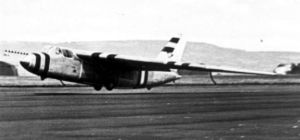Short SB.1
| SB.1 | |
|---|---|
 |
|
| Short SB.1 during landing c.1951 | |
| Role | Experimental glider |
| Manufacturer | Short Brothers |
| Designer | David Keith-Lucas |
| First flight | 14 July 1951 |
| Status | Company experimental project |
| Number built | 1 |
| Variants | Short SB.4 Sherpa |
The Short SB.1 was a British tailless glider designed by David Keith-Lucas and Professor Geoffrey T.R. Hill and built by Shorts as a private research venture to test the concept of the aero-isoclinic wing, it being the first aircraft to incorporate this feature.Template:Run-on sentence It was in effect a one-third scale glider version of Keith-Lucas' ambitious preliminary design P.D.1, intended to meet the Air Ministry's (V bomber) specification B.35/46, which was the basis for the Avro Vulcan, the Handley-Page Victor and the Vickers Valiant.
After extensive testing with wind-tunnel and flutter models, the design team proposed that a manned glider be built. Shorts (Belfast) undertook construction on a single-seat glider incorporating the "aero-isoclinic" wing originated by Professor Hill. This radical wing configuration was designed to maintain a constant angle of incidence regardless of flexing, by placing the torsion box well back in the wing so that the air loads, acting in the region of the quarter-chord line, have a considerable moment arm about it. The torsional instability and tip stalling characteristics of conventional swept wings were recognised at the time, together with their tendency to aileron-reversal and flutter at high speed. It was to prevent these effects that the aero-isoclinic wing was designed.
The SB.1 glider was designed to be an inexpensive, simple machine, constructed primarily of spruce with reinforced sections using light alloy steel. The all-important wing controls had "elevons" pivoted on long, tapered light-alloy tubes extending from the leading edge of the tip, just inside the fixed part of the wing (illustrated by photographs in the Short SB.4 Sherpa article). The pivoting mechanism had a double-ball bearing unit on the inboard end with main loads transferred to a needle roller bearing at the outboard end of the fixed wing. Anti-balance tabs were fitted along trailing edges along with small pneumatically actuated flaps under the inboard sections. When the elevons were rotated in the same direction they functioned as elevators; when rotated in opposite directions they functioned as ailerons.
...
Wikipedia
